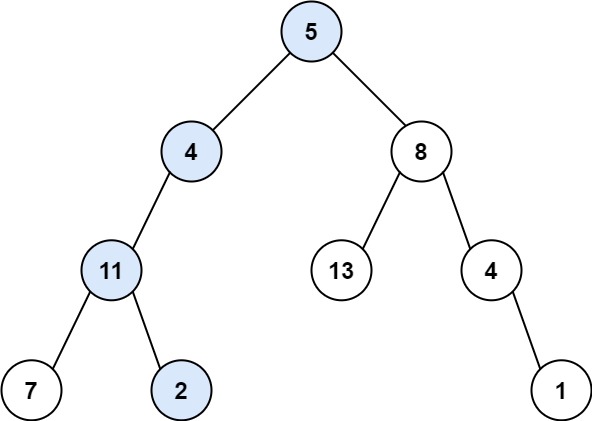Given the root of a binary tree and an integer targetSum, return true if the tree has a root-to-leaf path such that adding up all the values along the path equals targetSum.
A leaf is a node with no children.
Example 1:

Input: root = [5,4,8,11,null,13,4,7,2,null,null,null,1], targetSum = 22 Output: true Explanation: The root-to-leaf path with the target sum is shown.
Example 2:

Input: root = [1,2,3], targetSum = 5 Output: false Explanation: There are two root-to-leaf paths in the tree: (1 --> 2): The sum is 3. (1 --> 3): The sum is 4. There is no root-to-leaf path with sum = 5.
Example 3:
Input: root = [], targetSum = 0 Output: false Explanation: Since the tree is empty, there are no root-to-leaf paths.
Constraints:
- The number of nodes in the tree is in the range
[0, 5000]. -1000 <= Node.val <= 1000-1000 <= targetSum <= 1000
A:
/**
* Definition for a binary tree node.
* struct TreeNode {
* int val;
* TreeNode *left;
* TreeNode *right;
* TreeNode() : val(0), left(nullptr), right(nullptr) {}
* TreeNode(int x) : val(x), left(nullptr), right(nullptr) {}
* TreeNode(int x, TreeNode *left, TreeNode *right) : val(x), left(left), right(right) {}
* };
*/
class Solution {
public:
bool hasPathSum(TreeNode* root, int targetSum) {
if(!root)
return false;
if( ! root->left && ! root->right)
return root->val == targetSum;
return hasPathSum(root->left, targetSum - root->val) || hasPathSum(root->right, targetSum - root->val);
}
};
public class Solution {
public boolean hasPathSum(TreeNode root, int sum) {
if(root==null)
return false;
return helper(root,sum);
}
private boolean helper(TreeNode root, int sum){
if(root ==null)
return sum==0;
return helper(root.left, sum-root.val) || helper(root.right,sum-root.val);
}
}
Mistakes:
1 :因为,对leaf的理解不对,只有当某个节点没有child的时候,它才是leaf。
而上面的方法,会让不是leaf的节点被当作节点
2: 即使是boolean类型的,要用的时候,也要 先显著的声明下,而不能用它的默认值。
(貌似避免不同平台的默认值不同)
Learned:
No comments:
Post a Comment